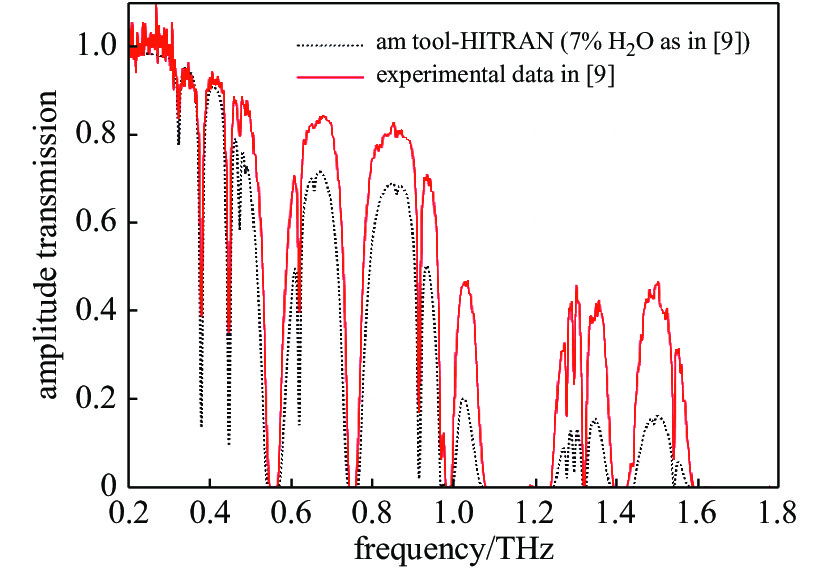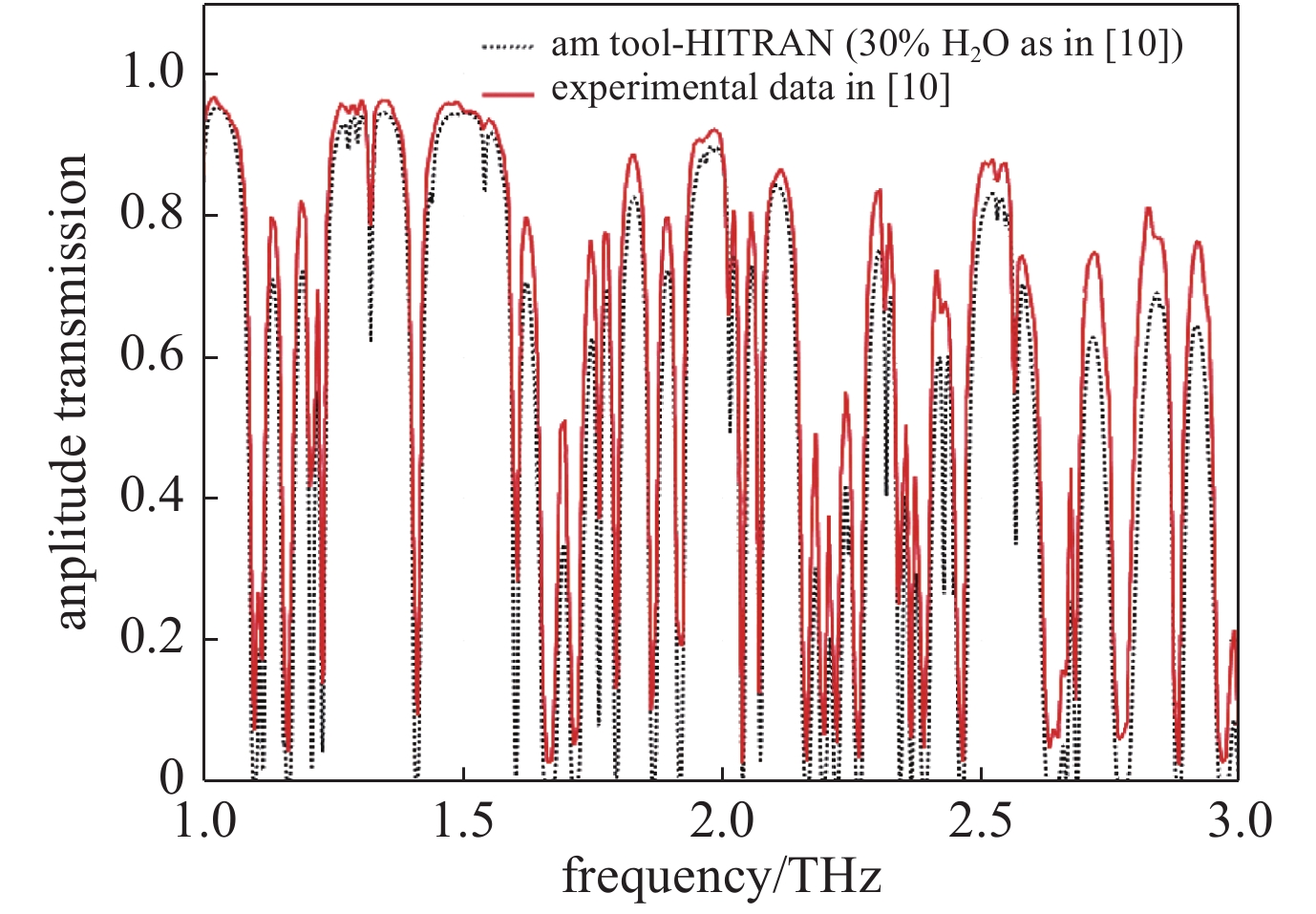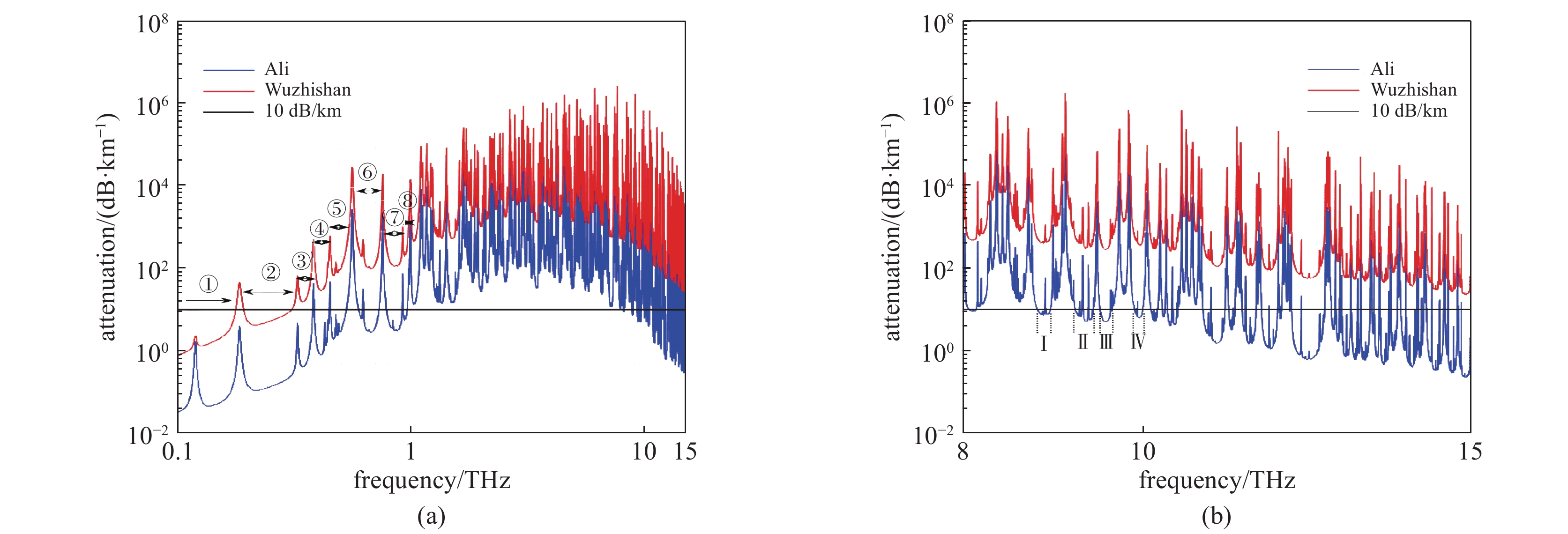Analysis of high-frequency atmospheric windows for terahertz communication between the ground and the satellite
-
摘要: 较大的传输路径损耗限制了太赫兹无线通信在大气中的传输距离,要想实现地面与卫星之间太赫兹波的长程传输,必须先找到低衰减的大气透明窗口。本文结合我国大气分布特点,通过大气辐射传输模型工具am(atmospheric model)对大气吸收衰减建模进行分析,从中选定适合我国地面与卫星太赫兹通信的理想地基站点;利用真实大气数据和分层传输理论,计算了地面与卫星之间太赫兹通信的总路径损耗,结合信号发射功率、天线增益、信噪比、噪声功率值和相应的路径衰减阈值,给出了天线增益分别为0~100 dBi时10~15 THz频段内的总可用带宽和大气窗口;通过将高海拔平台作为地面与卫星之间太赫兹通信的中继链路,给出了1~15 THz频段内的可用大气窗口,为我国地面与卫星通信链路的建立、地基站点和通信频段的选取提供了理论和数值参考。Abstract: The large path loss limits the transmission distance of terahertz wireless communication in the atmosphere. To realize long-range transmission of terahertz waves between the ground and the satellite, the first and key step is to find low attenuation atmospheric transparent windows. In this paper, based on the characteristics of atmospheric distribution in China, atmospheric model (am) is used to compute and compare atmospheric absorption attenuation of terahertz waves in two representative cities, and obtain the most ideal ground-based site suitable for terahertz communication between the ground and the satellite in China. Subsequently, by means of real atmospheric data and layered transmission theory, the total path loss of terahertz communication between the ground and the satellite is calculated. Combined with the signal transmit power, antenna gain, Signal-to-Noise Ratio (SNR), noise power and the corresponding path loss threshold, the total usable bandwidth and atmospheric windows in the 10−15 THz frequency band are given. Moreover, by taking the High Altitude Platform as the terahertz communication relay link between the ground and the satellite, the usable atmospheric windows in the 1−15 THz frequency band with antenna gain of 0−100 dBi are given, which provide theoretical and numerical reference for the establishment of ground-satellite communication links and the selection of ground-based sites and communication frequency bands in China.
-
图 4 地基站点与卫星(G-S)、高海拔平台与卫星(HAP-S)、地基站点与高海拔平台(G-HAP)之间太赫兹通信总路径损耗,(b)是(a)的局部图
Figure 4. Total path loss of terahertz communication corresponding to Ground-based site-to-Satellite (G-S), High Altitude Platform-to-Satellite (HAP-S) and Ground-based site-to-High Altitude Platform (G-HAP), where (b) is a local graph of (a)
表 1 两个站点经纬度、海拔、气压、温度、相对湿度数据
Table 1. Longitude and latitude, altitude, air pressure, temperature and relative humidity data of two sites
site longitude/(°) latitude/(°) altitude/m p/hPa T/K RH/% Ali 80.026 32.326 5060.0 544.4 259.4 37 Wuzhishan 109.52 18.77 327.2 979.5 292.2 81 注:数据来源于MERRA-2中2007-2016年1,2,12月平均数据和中国气象数据网2019年1,2,12月平均数据。 表 2 3种通信场景下的可用带宽统计
Table 2. Usable bandwidth statistics in three communication cases
case total antenna gains/dBi usable bandwidth/THz total 0.2~1 THz 1~10 THz 10~15 THz ground-based site
to orbiting satellite
(G-S)0 0 0 0 0 20 0 0 0 0 40 0 0 0 0 60 0.057 2 0.057 2 0 0 80 0.323 7 0.323 7 0 0 100 2.957 85 0.587 55 0 2.370 3 high altitude platform
to orbiting satellite
(HAP-S)0 0 0 0 0 20 0 0 0 0 40 0 0 0 0 60 0.014 75 0.014 75 0 0 80 1.837 3 0.795 8 1.041 5 0 100 14.617 1 0.798 1 8.836 3 4.9827 Ground-based site
to high altitude platform
(G-HAP)0 0 0 0 0 20 0 0 0 0 40 0 0 0 0 60 0.250 95 0.250 95 0 0 80 1.388 1 0.566 25 0 0.821 85 100 4.353 35 0.633 35 0.296 3.424 -
[1] Xia Qing, Hossain Z, Medley M, et al. A link-layer synchronization and medium access control protocol for terahertz-band communication networks[C]//2015 IEEE Global Communications Conference. 2015: 1-7. [2] 王玉文. 太赫兹辐射大气传输特性研究与信道分析[D]. 绵阳: 中国工程物理研究院, 2017.Wang Yuwen. Atmospheric propagation characteristics and capacity analysis of terahertz wave[D]. Mianyang: China Academy of Engineering Physics, 2017). [3] Akyildiz I F, Jornet J M, Han Chong. Terahertz band: next frontier for wireless communications[J]. Physical Communication, 2014, 12: 16-32. doi: 10.1016/j.phycom.2014.01.006 [4] Shi Shengcai, Paine S, Yao Qijun, et al. Terahertz and far-infrared windows opened at Dome A in Antarctica[J]. Nature Astronomy, 2017, 1: 0001. doi: 10.1038/s41550-016-0001 [5] Gordon I E, Rothman L S, Hill C, et al. The HITRAN2016 molecular spectroscopic database[J]. Journal of Quantitative Spectroscopy and Radiative Transfer, 2017, 203: 3-69. doi: 10.1016/j.jqsrt.2017.06.038 [6] Paine S. The am atmospheric model[R]. Smithsonian Astrophysical Observatory, 2012. [7] Molod A, Takacs L, Suarez M, et al. Development of the GEOS-5 atmospheric general circulation model: evolution from MERRA to MERRA2[J]. Geoscientific Model Development, 2015, 8(5): 1339-1356. doi: 10.5194/gmd-8-1339-2015 [8] Jornet J M, Akyildiz I F. Channel modeling and capacity analysis for electromagnetic wireless nanonetworks in the terahertz band[J]. IEEE Transactions on Wireless Communications, 2011, 10(10): 3211-3221. doi: 10.1109/TWC.2011.081011.100545 [9] Yang Yihong, Mandehgar M, Grischkowsky D R. Broadband THz pulse transmission through the atmosphere[J]. IEEE Transactions on Terahertz Science and Technology, 2011, 1(1): 264-273. doi: 10.1109/TTHZ.2011.2159554 [10] Wohnsiedler S, Theuer M, Herrmann M, et al. Simulation and experiment of terahertz stand-off detection[C]//Proceedings of SPIE 7215, Terahertz Technology and Applications II. 2009: 101-108. [11] Saeed A, Gurbuz O, Akkas M A. Terahertz communications at various atmospheric altitudes[J]. Physical Communication, 2020, 41: 101113. doi: 10.1016/j.phycom.2020.101113 [12] Schneider T, Wiatrek A, Preussler S, et al. Link budget analysis for terahertz fixed wireless links[J]. IEEE Transactions on Terahertz Science and Technology, 2012, 2(2): 250-256. doi: 10.1109/TTHZ.2011.2182118 [13] Han Chong, Bicen A O, Akyildiz I F. Multi-wideband waveform design for distance-adaptive wireless communications in the terahertz band[J]. IEEE Transactions on Signal Processing, 2016, 64(4): 910-922. [14] Hwu S U, deSilva K B, Jih C T. Terahertz (THz) wireless systems for space applications[C]//2013 IEEE Sensors Applications Symposium Proceedings. 2013: 171-175. [15] ITU-R S. 1590 FRENCH-2002, Technical and operational characteristics of satellites operating in the range 20-375 THz[S]. -






 下载:
下载:




